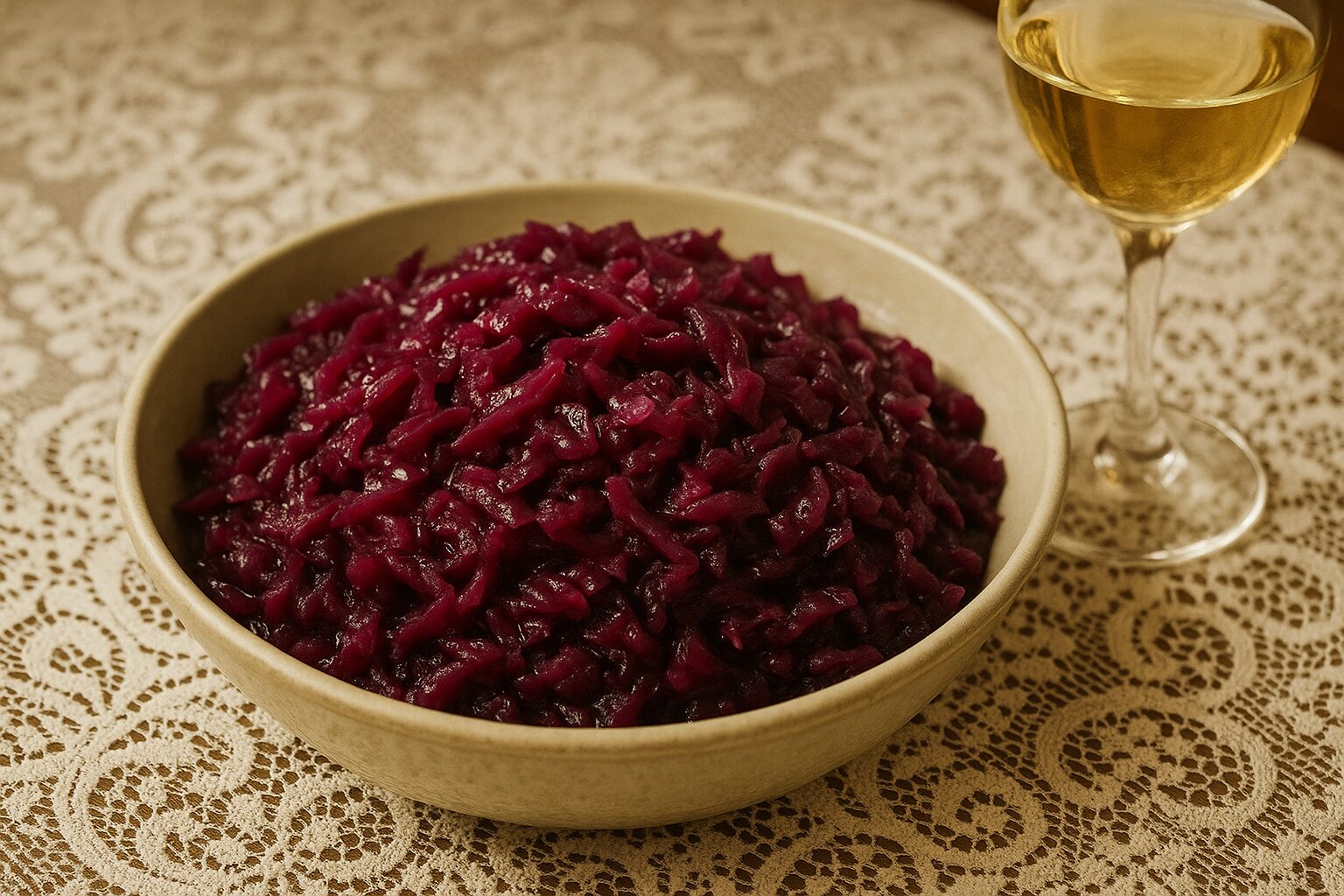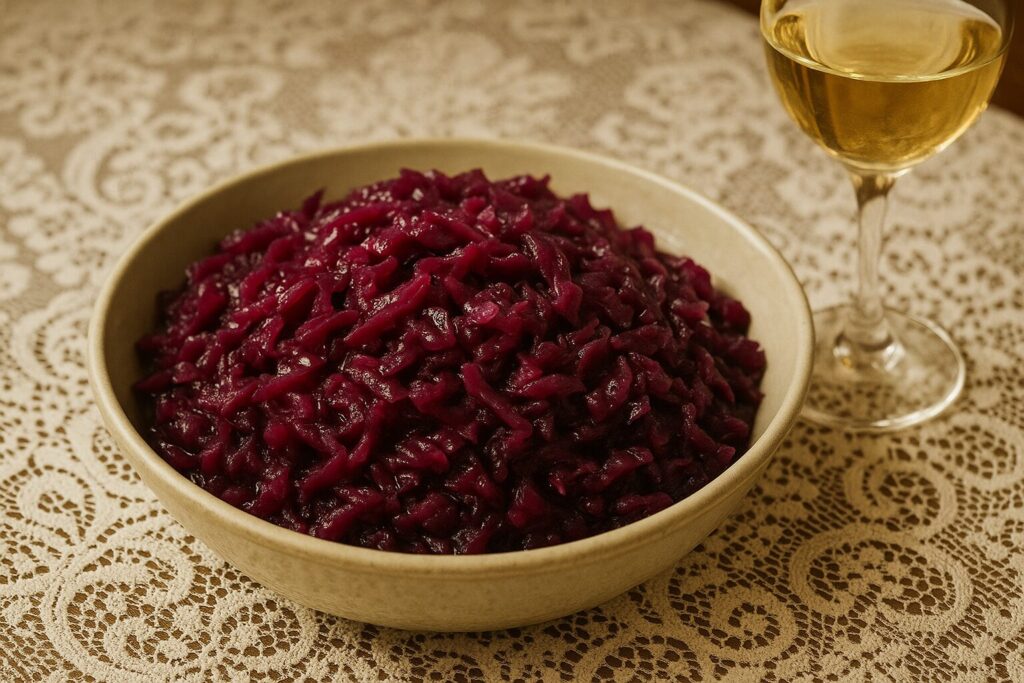Red cabbage. It’s not just a vegetable; it’s a vibrant, jewel-toned culinary experience. And when prepared the German way, as Rotkohl, it transcends the ordinary and becomes a deeply satisfying, comforting dish. Forget the bland, watery versions you might have tried or the jarred versions in the grocery stores. We’re talking about a sweet and sour symphony of flavors, a tender, melt-in-your-mouth texture, and an aroma that will transport you straight to a cozy German kitchen.
For generations, Rotkohl has been a staple on German tables, especially during the colder months and festive occasions like Christmas. It’s the perfect accompaniment to roasted meats like pork, goose, Rolauden or duck, and it adds a touch of elegance and warmth to any meal. Today, I’m thrilled to share my family’s recipe, passed down from my Oma (grandmother), a true master of German homemade cooking. This isn’t just a recipe; it’s a glimpse into a culinary heritage. So, put on your apron, grab a head of red cabbage, and let’s unlock the magic of authentic German Rotkohl!

Oma’s German Red Cabbage (Rotkohl)
Ingredients
Equipment
Method
- Remove the outer leaves of the red cabbage if they are wilted or damaged. Cut the cabbage in half through the core. Place one half cut-side down on a cutting board and thinly slice it. Repeat with the other half. You can also use a mandoline for even slicing.
- Peel and chop the onion. Peel, core, and chop the apples into small pieces.
- In a large, heavy-bottomed pot or Dutch oven, melt the butter or heat the oil over medium heat. Add the chopped onion and sauté until softened and translucent, about 5-7 minutes.
- Add the sliced red cabbage and chopped apples to the pot. Stir well to combine with the sautéed onion.
- Pour in the red wine vinegar, sugar, red wine (if using), and water or vegetable broth. Add the bay leaves, cloves, and allspice. Season with salt and pepper to taste.
- Bring the mixture to a simmer, then reduce the heat to low, cover the pot, and let it simmer for at least 1.5 to 2 hours, or until the cabbage is tender and the flavors have melded together beautifully. Stir occasionally to prevent sticking. The longer it simmers, the more tender and flavorful it will become.
- After simmering, taste the Rotkohl and adjust the seasoning as needed. You may want to add more sugar for sweetness, vinegar for tanginess, or salt and pepper for overall flavor.
- Before serving, remove the bay leaves and cloves from the Rotkohl.
- Serve the Rotkohl warm as a side dish with roasted meats, sausages, or dumplings. It’s also delicious served cold as part of a salad or as a topping for sandwiches.
Nutrition
Tips and Tricks for Red Cabbage Success:
- Don’t Overcook: While long simmering is key, be careful not to overcook the cabbage to the point where it becomes mushy. You want it to be tender but still have some texture.
- Adjust the Sweetness and Sourness: The beauty of Rotkohl is that you can customize the sweetness and sourness to your liking. Add more sugar for a sweeter taste or more vinegar for a tangier flavor.
- Make it Ahead: Rotkohl actually tastes better the next day, as the flavors have more time to meld together. You can make it a day or two in advance and reheat it before serving.
- Freezing: Rotkohl freezes well, making it a great option for meal prepping. Allow it to cool completely before transferring it to freezer-safe containers.
- Experiment with Variations: Feel free to experiment with different variations of Rotkohl. Try adding different types of apples, spices, or even a splash of balsamic vinegar for a unique twist.
A Taste of Tradition: The Enduring Appeal of Rotkohl
German red cabbage, or Rotkohl, is more than just a recipe; it’s a connection to tradition, a taste of home, and a celebration of simple, wholesome ingredients. This recipe, passed down through generations, is a testament to the enduring appeal of classic German cuisine.
So, the next time you’re looking for a flavorful and comforting side dish, give this Rotkohl recipe a try. You might just discover your new favorite way to enjoy red cabbage. And who knows, maybe you’ll even start your own family tradition! Guten Appetit! (Enjoy your meal!)



FAQ
What’s the secret to getting that perfectly balanced sweet and sour flavor in German Red Cabbage?
The key is layering your flavors! Start with a good base of rendered bacon fat or butter for richness. Then, balance the natural sweetness of the cabbage with a quality vinegar like apple cider vinegar or red wine vinegar. A touch of sugar or honey helps round it out, but don’t overdo it! Taste frequently and adjust the vinegar and sweetener until you achieve that harmonious sweet and sour profile. Some people also add a tart apple for an extra layer of flavor and acidity.
How do I prevent my red cabbage from turning an unappetizing blue color during cooking?
The color change is due to a reaction with the alkaline water. To prevent this, always add an acidic ingredient early in the cooking process. This could be vinegar (apple cider or red wine are great choices), lemon juice, or even a splash of red wine. Adding the acid at the beginning helps to set the vibrant red color and keep it from fading or turning blueish.
What are some interesting variations or additions I can make to my German Red Cabbage to elevate the flavor?
Absolutely! Feel free to experiment. Some delicious additions include:
Spices: A pinch of ground cloves, allspice, or caraway seeds can add warmth and depth.
Fruits: Tart apples (like Granny Smith or Honeycrisp) are classic, but you could also try adding cranberries or even a few dried cherries for a unique twist.
Nuts: Toasted walnuts or pecans add a lovely textural contrast.
Liquor: A splash of red wine or even a bit of port wine can enhance the richness and complexity.
How long does German Red Cabbage keep, and what’s the best way to store it?
German Red Cabbage is a fantastic make-ahead dish! It keeps very well in the refrigerator for up to 5 days. Store it in an airtight container to prevent it from drying out or absorbing other flavors. The flavors actually meld and deepen over time, making it even more delicious the next day!
I’m having trouble getting my red cabbage to become tender. What am I doing wrong?
Patience is key! Red cabbage can be a little tough, so it needs enough time to soften. Make sure you’re cooking it low and slow, allowing the heat to gently break down the fibers. Also, adding a little bit of liquid (like water, broth, or apple juice) helps to create steam and tenderize the cabbage. If it’s still tough after a while, add a bit more liquid and continue cooking until it reaches your desired tenderness.



